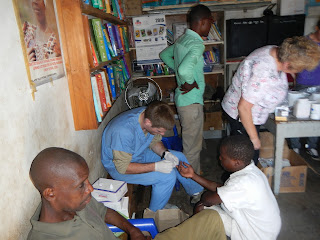Besides the current outpatient clinic, the building of a maternal ward is underway. When it is completed, Peter hopes to have a blood center where he can give transfusions. I feel certain if that happens that little ones will benefit from that as well as the mothers. Until then, the mothers and babies are at the mercy of the local district hospital.
Pothawira also has an orphanage and a school. The orphanage has over 100 kids, and is just finishing another duplex to accommodate another 20 kids (well, technically less than that, as technically they should only have 100 kids now, but how do you turn away a child?).
For more information on any of these projects, go to Pothawira Village online or on Facebook. When we were just there, they had 4 new kids from one family. They came in rags. Emma Maseko had some donated clothes for the little boy but nothing for the girls - except the youngest who fit into some donated pajamas. We went to the market and bought all the girls a dress each. Such a little thing but made them so happy. Several of the teen age girls no longer have shoes that fit!
For the pictures: please be aware that many of these are graphic. Monday seemed to be abscess day - we did abscesses on legs, heads, hands and faces. If it is huge and going to be very painful, the patient is given ketamine and valium direct IV push. One lady was falling over before the needle was out of her arm. They are laid on a stretcher (same stretcher for all, no changing sheets..oh, no sheets at all, just a plastic tarp), no IV fluids, no monitors, no oxygen. They are sprawled out while Peter does his 'minor surgery', then they are lifted into a wheelchair and taken to recovery. Recovery used to be under the tree out back, but with the new building, it is now the porch (konde) where the patients gather to be seen. Some wounds are packed, some are not. Some patients come back for their wound care, some do not. I saw two children with specific instructions to get daily injections and come back for 'review' (re-check). Neither came back - one with several periorbital infection, the other with mastoiditis. Some of these patients - both adults and children - would have been admitted in the US, gone to surgery for their abscesses or at least had IV antibiotics. Life is hard here. The local hospitals have almost no medication. We saw several people referred FROM the district hospital to Pothawira for a variety of reasons, mostly involving medications / wound care / sonogram.
Look at the photos and remember that if Pothawira didn't exist, many of these people would die. Peter actually amputated the last joint of an index finger due to gangrene. He opened a hand wound that would be in surgery in the US. If so inclined, contact me - Peter always needs medical help, plus the medications and tests are expensive.
Periorbital cellulitis - this child never came back for additional injections and review.
Shingles. Mom was non-reactive. Child otherwise healthy. You always have to worry about HIV in children with shingles.
Child with an abscess on her foot - Mom said it 'just started' and then ruptured.
Baby with an ugly rash - I suspect impetigo but who knows?
Lady with a history of having a stick poke her foot. This photo was on Monday. The wound was cleaned and dressed. When she came back Wed. the exudate was bright green. I got 'called in' on the case - found she was diabetic (she did not know that), and recommended sending her to the district hospital for IV antibiotics (she was on orals already) and managing her sugar. Who knows if she will go, and worse yet, who knows if she does go if they will have the necessary medications?
Massive hand abscess between 4th and 5th fingers. Patient said it 'just started on its own'. He is already 'out' on the stretcher.
Splitting the fingers apart and then exploring the wound with his finger.
Peter smiling during the procedure. Note that the patient is in never-never land, with his legs hanging off of the stretcher!
Opening a preauricluar abscess. This poor lady was sitting in the room watching the hand abscess procedure. If it were possible for an African to turn green, she was that color! She was less than happy about what was going to happen to her, but she was 'out' before the meds were totally injected!
Watching the pus pour out of her abscess and down into her ear was disgusting!
After the surgery, on her way to 'recovery'.
The recovery room.
Another view of the recovery room. After they wake up, they get their prescriptions and walk home.
Here is Peter working on a leg abscess. This guy did return for injections and wound care.
Child getting a hemoglobin checked. Look at those big tears coming out of his eyes!
On a happier note, this is me with my translator, nurse Loness.
Julita, another of the nurses.
Limbanie, another of the nurses.
Joey Swartz with all three of the nurses.
Julia working with the hemoglobin machine.
Line outside of my office.
Loness and I in my office. The patients come in through the door (where photographer Joey was standing), then exit door behind me - if they are going for testing, they come back to door behind me, so I often have two lines coming into the office. And you can see how big it is!
These were our last clinics for this trip. I may post some photos on facebook for the last couple of days here, but probably no more blogs. Friend me on Facebook if you haven't done so if you want more photos and background.
Thanks again to all the supporters, both materially, medically and prayerfully!
Until next year!






























































